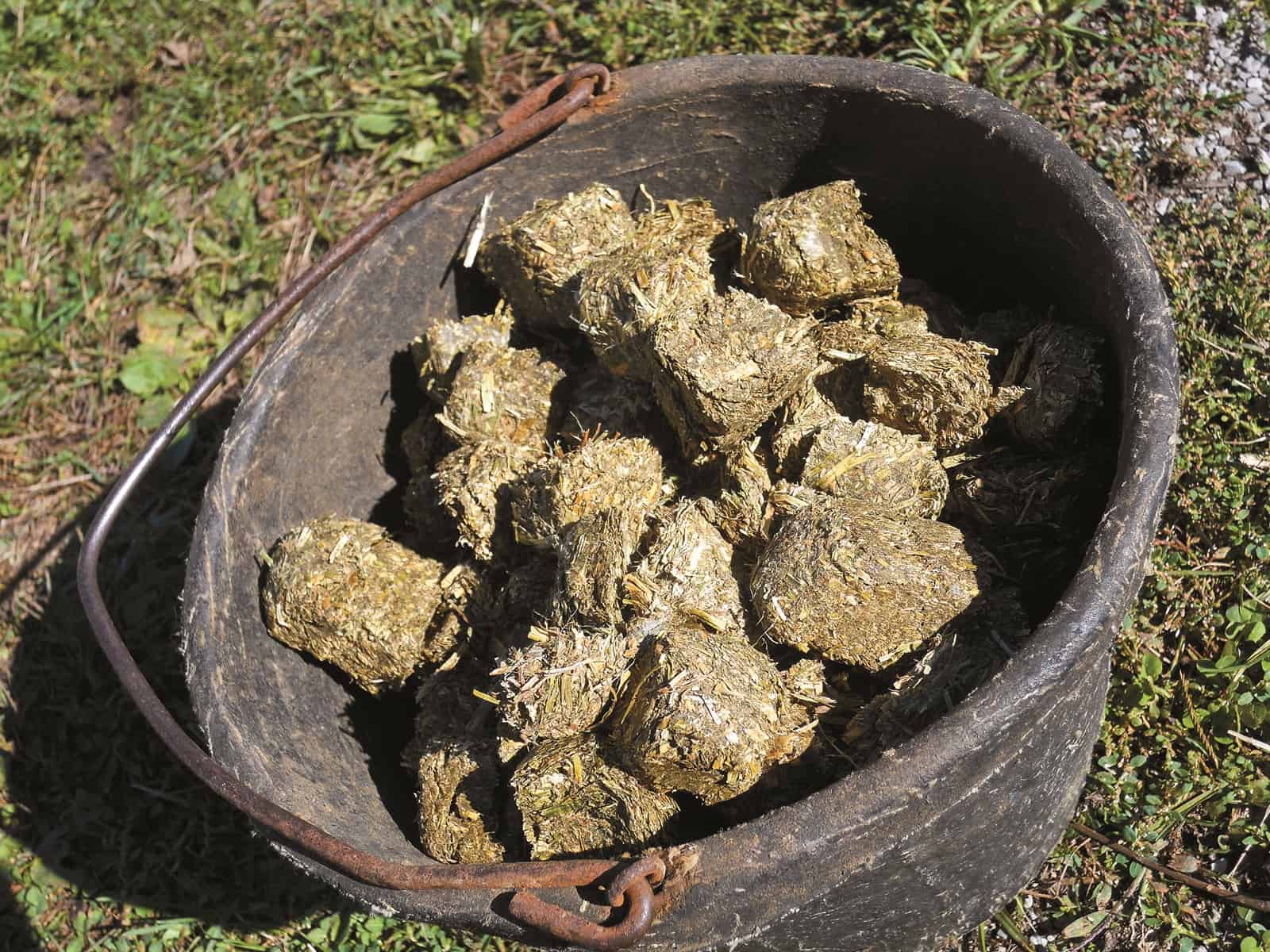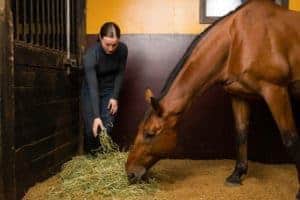Increasing Chew Time for Hay Cubes and Pellets
- Posted by Clair Thunes, PhD

Q: I have a fair amount of experience feeding senior horses. At one point I had three of them on either hay pellets or hay cubes due to dentition issues that prevented them from eating long-stem hay. Because they could consume the cubes or pellets fairly quickly, there would be long stretches during the day and night where there was no forage for them to eat; at that point, they started chewing wood in the barn and on trees.
I currently have two seniors, one of which will chew on his buddy’s hay and spit out the quids, so chew time is not a problem. Before, I had one gelding who would not only chew his hay but would then eat other horses’ quids, which resulted in mild impactions throughout in the last two years of his life.
My question is: What can I do to appease the need to chew for equids that can only eat hay pellets or cubes, chopped hay, or complete feeds because their teeth are no longer effective for chewing long-stem forage? Would small-hole haynets allow them to just get a few pieces of hay at a time to chew on while reducing the risk of impactions caused by swallowing unchewed long-stem forage? —Karen, via e-mail
A: Chew time is an important consideration not just because it gives your horse something to do and more closely resembles the horse’s natural feeding behaviors, but also because chewing results in saliva production. Saliva lubricates the feed being consumed, helps its passage down the esophagus, and contains a significant concentration of bicarbonate and calcium—both of which buffer stomach acid.
Horses in a natural setting spend the majority of the day foraging and chewing, and they constantly secrete stomach acid whether they are eating or not. The near-constant chewing and saliva secretion continually buffers the secreted acid. The highly fibrous plant matter being consumed also buffers stomach acid and forms a floating mat on the surface of the acid, preventing it from splashing around.
When the horse spends less time chewing—whether its due to reduced forage intake, the type of forage, or the method of forage provision—he produces less saliva and can’t buffer the stomach acid as well. This could increase a horse’s risk of developing gastric ulcers in addition to developing undesirable behaviors such as wood chewing, as you’ve described.
Meal-feeding restricted amounts of hay reduces total chewing compared to the amount of chewing that would occur if the horse was on pasture full time. Many horses will consume a flake or two of hay in less than a couple of hours, leaving long periods between meal times with no chewing. Slow feeders can increase the time spent chewing and, thus, producing saliva.
For horses with poor dentition, long-stem hay might no longer be a viable option because they cannot chew it adequately. Hopefully, this results in quids—balled-up mouthfuls of partially chewed hay that fall out of the horse’s mouth. I say “hopefully” because the other option is that the horse swallows the inadequately chewed hay and is at risk of impaction colic should the hay get stuck in the gastrointestinal tract. Of course, the major downside to quidding is that the horse gets no nutritional value from the hay when it’s not actually consumed.
Some senior horses appear to chew hay fine, but don’t maintain or gain weight with it as they have in the past. This could be because they’re no longer as effective at digesting hay as they used to be. Some of these senior horses might develop loose manure due to mild colitis caused by the hay irritating the colon. I have worked with several such horses, and all have improved in body condition and manure quality by consuming a diet made up either partially or completely of hay pellets.
Hay pellets or cubes are a good solution for horses with poor dentition and other horses that might require pelleted diets, such as those described previously or with equine asthma that need dust-free or low-dust feed. However, because the hay has been chopped up to a very fine size prior to being turned in to the pellet, it takes very little chewing to break the pellets into an easily swallowed size. This results in reduced chew time and saliva production. If your horse eats a flake or two of hay in only a couple of hours, the time it will take him to eat a similar weight of pellets will be substantially less.
For your horse that reliably spits out quids when chewing hay, you could continue to give him access to a small amount of hay; however, I suspect that the majority of the saliva being produced during chewing ends up in the quid and not in the stomach. Additionally, there is the risk that some of the hay is being consumed and increasing impaction colic risk, so I would discuss hay-feeding strategies with your veterinarian. Small-hole haynets might result in better overall chewing and fewer quids, so this might be a good option, as well, but again I would discuss this with your veterinarian who can fully assess your horse’s situation.
A better solution might be an automatic pellet feeder—essentially, a slow feeder for pellets. There are several versions on the market. Basically, you fill the feed hopper with your hay pellets and program the feeder to release a certain quantity at your preferred time. Most of these feeders sit outside the stall and direct the feed into a bucket in the stall by way of a funnel. Some feeders will drop all the feed you want at once—for example, you program it to feed all 6 pounds of pellets at 7 a.m. Other feeders let you program them to feed that same 6 pounds of feed in intervals—for instance, you can program it to feed approximately 48 2-ounce portions every 30 seconds or so. These feeders allow you to spread your pellet meals at intervals throughout the day to simulate grazing.
You can use these same feeders to provide concentrates to horses that can eat hay, spacing their pelleted or textured grain meals in small portions throughout the day. They are also a great way to supplement a hay-based diet with hay pellets. For example, maybe you want to program it to feed some pellets at 6 p.m. in case you get home from work late.
You can find a number of automatic pellet manufacturers by doing an online search using terms such as equine pellet feeder.
Hopefully using a solution such as an automatic feeder will keep your horses eating more consistently throughout the day and prevent them from looking for alternatives to chew such as your trees or barn!

Written by:
Clair Thunes, PhD
Related Articles
Stay on top of the most recent Horse Health news with













3 Responses
Make the dry lot into a Pasture Paradise. A log, toys, slow feeders hung around the perimeter, water, salt and loafing area all in different places. Cubes in a roll-it toys would extend time. I have an old toboggan with holes in it, put a net with hay on it and douse it with warm water. Removes dust, softens the hay and slows them down even more. Right now, I’m walking a half mile loop in the field that has 2′ of snow and dropping skinny flakes of hay every 300′ for my elderlies. Its a use it or lose it world and the movement keeps them strong. Pellets are too processed for me./beet pulp shreds with no molasses. It may not be long stemmed fibre, but more fibre than pellets. Temps can plunge to -40 overnight and the colder it gets, the more the horses tighten up on the water consumption. I push the water. I feed salt to drive thirst. Each horse gets, 1lb of beet pulp and 2lbs of timothy cubes total,in twice daily servings. Since 1lb of beet pulp = 2lb hay and 1lb of cubes = 1lb hay. That means I have replaced 4 lbs of hay. I was already consistently saving $400/year on hay with the slow feeders. 2qts of hot water goes into that pail. Its soupy and I dump it n a child’s toboggan, where they rummage around for the goodiies without spilling a drop. Those sleds are licked clean every time, water and all. Hope this helps with some ideas.
I would also be interested in more information about feeding seniors soaked cubes. My senior has been living quite well on a twice daily feeding of soaked alfalfa cubes and sweet feed. He quids hay and grass but seems content to sleep most of the day between feedings. The downside of this schedule is that my husband and I are completely tied down to this horse’s feeding schedule. We haven’t taken a vacation together in years because of the difficulty in finding a farm sitter. Automated feeding mechanisms simply wouldn’t work in our situation. I guess I’m just posting this so other people in a similar situation know they aren’t alone.
Hello, I read the article in hopes to obtain some information regarding substitutes that can be used when a horse is being fed soaked cubes twice a day, but lives on a dry lot and is going several hours in between feeding with nothing to graze on. I read this could cause ulcers, but I’m not seeing any recommendations. Thanks